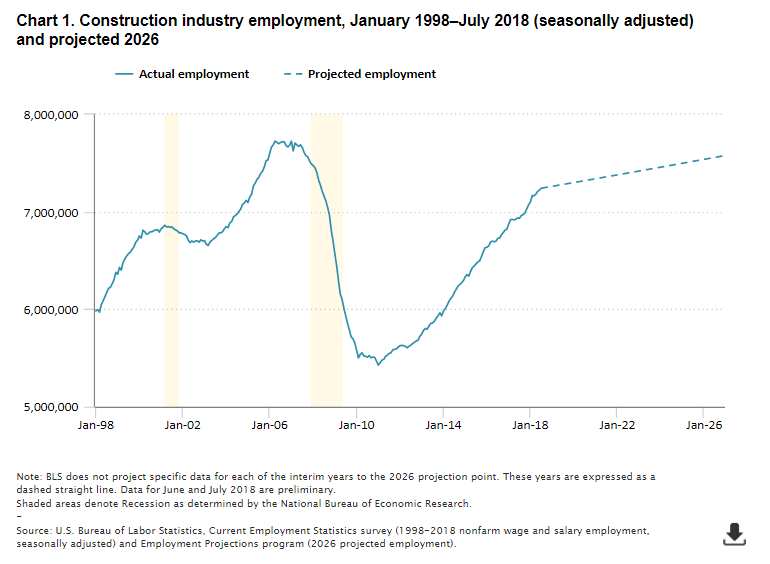How New Approaches and Technology Can Help You Do More With Less
The Associated General Contractors of America released a survey recently in partnership with Autodesk, and the results are chilling; about 80% of construction companies can’t find the workers they need. If you’ve experienced a construction labor shortage or are having a hard time finding qualified, skilled workers, you’re not alone. Despite steady industry growth, companies are still struggling to fill key roles on the jobsite, and as a result, are at risk of missing out on jobs or extending project timelines.
But, before you panic, remember that statistics can only tell one part of the story. While the construction labor shortage is a threat to your bottom line, the right tactics and tools can mitigate your risk exposure. Understanding the reasons behind this shortage and employing some creative tactics can help you cope with a reduced workforce, without sacrificing quality or turning down new projects.
But first, let’s dive a bit more into the effects of the construction labor shortage in this newly released infographic from Autodesk:
Where Did Everybody Go?
It wasn’t so long ago that the industry actually had a surplus of workers; at the height of the housing bubble, the U.S. added 900,000 construction jobs. However, during the 2006-2011 recession, construction companies shed about 2.3 million jobs. Nearly a decade later, the industry has recovered(along with the jobs),but there seems to be no one around to take them
Today, the Bureau of Labor Statistics reports there are over 404,000 unfilled construction positions. So, where did those workers go? Several factors are contributing to the construction labor shortage:
- During the recession, skilled workers who were unable to find work joined new industries or dropped out of the workforce entirely.
- Baby Boomers are beginning to retire in record numbers and are leaving all industries, including construction.
- Millennials are entering the market, but many have unrelated degrees, no training or connection to construction and little interest in jobs in the field.
- While immigrant workers can fill the gap in many cases, there is a language barrier in the hiring and training process.
- Many construction companies have not innovated their hiring processes and are not attracting and tapping into new talent markets.
What Are the Results of the Construction Labor Shortage?
The impact of the labor shortage has had a ripple effect across the construction industry. Most significantly, it has impacted the bottom line of construction firms. According to the recent AGC survey, the struggle is all too real:
- 43% report that costs have been higher
- 44% report putting higher costs into bids or contracts
- 44% report projects have taken longer than anticipated
How Can Companies Cope with the Construction Labor Shortage?
Despite booming growth, the industry is in a panic over the construction labor shortage—and for a good reason. Nonetheless, there are several ways to improve the number of skilled workers, but many of them take time. Outreach to high schools and older teens to promote the industry, appealing to young adults, and even aggressively recruiting at local trade schools do help, but these are not immediate solutions.
To fix the labor crisis, construction companies should be investing in cutting edge technology, in addition to new strategies to retain and attract top talent.
Construction Software Can Help Bridge the Gap
In many cases, choosing the right construction software can make a big difference for foremen and superintendents by allowing them to get more done through increased efficiency and productivity. And many construction companies are starting to use it as a real solution for the labor shortage. In the AGC survey, contractors reported taking the following actions:
- 29% are investing in technology to automate processes
- 25% are using more cutting-edge solutions, including drones, robots and 3D printers
- 23% are adopting methods to improve jobsite performance, including relying on lean construction techniques, using virtual construction tools like Building Information Modeling and doing more off-site prefabrication
If your worksites are not operating at peak efficiency, you’ll feel the pinch of the construction labor shortage far more than your competitor, who is using the latest technology to streamline their organization.
The right construction software can help you run a more efficient jobsite in several key ways by empowering you to:
Improve Communication and Collaboration
Eliminate or drastically reduce the amount of time workers spend waiting for approval, waiting to clarify an issue, or waiting for the answer to a question. Mobile devices and construction software make it easier to connect the office to the field in real-time. This way, you can always find the most up-to-date plans or reach the person you need to hear from so you can get an answer right away. When you eliminate unnecessary downtime, you can get more done and make the most of the workforce you have.
Eliminate Misallocation
Are the right teams deployed at the right time? Are your team members able to get right to work, or do they end up waiting until a critical piece of rental equipment shows up or the team before them gets done? Construction software can ensure that everyone is on the same page and that you are allocating the resources you have effectively and efficiently. When there is only one record or source of information for a project, you can be sure that everyone is reading the same reports every morning and planning accordingly.
Create a Tech-Friendly Culture
Those Millennials you’re hoping to hire are digital natives; they’ve grown up with technology and embrace it fully. Your younger team members have an innate understanding of software and digital tech and will embrace and make the most of construction software.
If you want a youthful workforce that can make the most of the available technology as they learn the construction business, now is the time to reach out to them. While the departure of Baby Boomers and skilled craftspeople leaves a big gap, many of these older, established construction pros were averse to technology and unable to make the most of the powerful and innovative tools they had at hand. Incorporating technology can make your company more appealing to younger workers and in turn, allow your Millennial workers to perform as efficiently as possible on your site.
Bridge the Language Barrier
The January 2017 Labor Force Statistics report indicates that 28.9% of the construction industry is Hispanic or Latino, and that number is only increasing with time. While that is great news for anyone worried about the construction labor shortage, the English-Spanish language divide brings some unique challenges. These workers are skilled and able to perform key jobs on your site but are at an increased risk of injury because training materials and even supervisors often relay important details solely in English. However, according to a new report, 53% of construction managers expect “an increase in the demand for foreign language skills on the jobsite in the next five years.”
The Spec on the Job Blog, notes, “Receiving instructions in Spanish would make numerous Hispanic workers more comfortable on the job and reduce the number of mistakes that happen due to misunderstandings. This reduction of errors would greatly benefit construction companies, which all tend to have a sizable amount of Hispanic workers.”
In addition to having bilingual supervisors, the right software can help bridge the gap by supporting localized languages and allowing your business to safely and effectively employ the abundant population of Spanish-speaking craftspeople.
How to Increase Construction Productivity in a Tight Labor Market: Plan Ahead
New construction technology seems to arrive every day; from 3D printing entire homes right on site to jobsite walking robots and AI that can predict needs and deploy assets with precision, technology can change the way we do business. An automated home build and robotic workers are still far in the future, at least for mainstream construction. Still, software that can boost your ability to collaborate, your communication abilities, and your overall efficiency is already here.
With the right insight into what can boost productivity, companies can overcome the unique problems you risk from being short handed on the jobsite. Don’t waste your time re-inventing the wheel and experimenting with solutions that may not work. Instead, take advantage of the lessons we’ve learned in our blog, Essential Construction KPIs to Improve Profits and Productivity.
A Shift Towards New Retention and Hiring Strategies
Construction is an industry that relies on humans. Forward-thinking construction companies are not only investing in technology and innovation, they are looking beyond traditional retention methods and labor pools to find talent. According to the AGC survey:
- 50% of contractors are engaged with career-building programs
- 66% of the firms report they have increased base pay rates for craft workers because of the difficulty in filling positions
- 29% report they are providing incentives and bonuses to attract craft workers
When considering new labor markets to recruit for construction jobs, firms may want to consider approaches tailored to untapped pools like women and veterans. Furthermore, investing in methods to improve company-wide diversity, not only benefits individual businesses, it creates a stronger industry overall. In an Autodesk Redshift blog, Jennifer Suerth, Vice President of Technical Services at Pepper Construction Company, commented, “As diversity increases in our industry, we will see increases in productivity because we will see new ideas being brought forward.” Thirty-percent of the staff at Pepper happen to be women, which is more than 20% above the industry average.
Meet the Construction Labor Shortage Head-On
Fortunately, there are strategies that construction companies can use to not only survive the current market but also thrive in it. When new workers are few and far between, it’s time to start making the most of the workforce you have. It begins with giving your team the technology necessary for them to be 100% efficient in their jobs, in addition to looking beyond traditional hiring and retention strategies. With this two-fold approach, it’s possible to lessen the impact of the construction labor shortage for your firm, while attracting the next generation of construction talent.
The Associated General Contractors of America released a survey recently and the results are chilling; about 80% of construction companies can’t find the workers they need. If you’ve experienced a construction labor shortage or are having a hard time finding qualified, skilled workers, you’re not alone. Despite steady industry growth, companies are still struggling to fill key roles on the jobsite, and as a result, are at risk of missing out on jobs or extending project timelines.
But, before you panic, remember that statistics can only tell one part of the story. While the construction labor shortage is a threat to your bottom line, the right tactics and tools can mitigate your risk exposure. Understanding the reasons behind this shortage and employing some creative tactics can help you cope with a reduced workforce without sacrificing quality or turning down new projects.




Responses